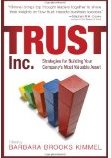Trust Inc.: Strategies for Building the Trust Asset – Chapter 1
 This is an abridged version of the opening chapter – “The Business Case for Trust” – of the just-published Trust, Inc.: Strategies for Building Your Company’s Most Value Asset.
This is an abridged version of the opening chapter – “The Business Case for Trust” – of the just-published Trust, Inc.: Strategies for Building Your Company’s Most Value Asset.
The book is a collection of 30-plus articles by diverse authors on trust in business. Edited by Barbara Kimmel of Trust Across America, the book covers issues ranging from measuring trust, diagnosing its presence or absence, managing trust and increasing trustworthiness, to improving people, companies, industries and societies.
Barbara and I co-authored the opening chapter. Other authors in the book include names like Steven M.R. Covey Jr., Ken Blanchard, James Kouzes and Barry Posner, Peter Firestein (investor relations), Laura Rittenhouse (financial candor), Jim Gregory (branding), and Linda Locke (reputation). And more.
Have a taste of the book, below. And click through here to see a complete table of contents and authors list. Whatever your interest in business in trust, you’ll find something here the addresses it.
The Business Case for Trust
by Barbara Brooks Kimmel and Charles H. Green: from Chapter 1 of Trust, Inc.,publisher Next Decade, November 2013.
Trustworthiness — once exemplified by a simple firm handshake — is a business value that has suffered erosion. We see this in how the public has grown increasingly cynical about corporate behavior—with good reason.
The PR firm Edelman found in a recent “Trust Barometer” survey that trust, transparency, and honest business practices influence corporate reputation more than the quality of products and services or financial performance. And yet, scandals and bad behavior continue to pile up.
Our view is that a company seriously interested in its reputation must increasingly focus not just on “business performance” as it is traditionally understood, but on being seen as trustworthy too.
We believe there is an important, material business case for trust. This doesn’t mean that trust isn’t or shouldn’t be justified on moral or societal grounds. Of course it should. But trust makes for good business as well. This essay will put forth the business case for trust by exploring the gap between low- and high-trust organizations’ performance. We will also offer a framework for assessing corporate trustworthiness, and point the way toward strategies for creating a trust-enhancing business model.
First, let’s look at the costs of low trust.
How low trust affects stakeholder outcomes
Low Trust in Society
Business operates in a social context; because of that, low trust in society-at-large costs business. Indirect examples include the TSA airport security program ($5.3 billion, not to mention the impact on tens of millions of business travelers), and the criminal justice system ($167 billion in 2004). Both of these examples are funded by taxes on individuals and business.
Businesses also shoulder direct tangible losses from crime ($105 billion), where they are often the victims.
A more obvious social cost for business is the cost of regulation. Economist Clyde Wayne Crews releases an annual report entitled “The Ten Thousand Commandments” that tallies federal regulations and their costs. In 2010, the federal government spent $55.4 billion dollars funding federal agencies and enforcing existing regulation. In 2013, The Washington Post reported that “the federal government imposed an estimated $216 billion in regulatory costs on the economy (in 2012), nearly double its previous record.”
Doing business in a low-trust environment is costly. Whether or not you believe that companies can, or should directly impact social conditions, one thing is clear. In aggregate, business bears a lot of weight for the cost of low-trust in our society.
Low Trust in Business Practices
Social costs on business, however, are just the tip of the iceberg. Far bigger costs are exacted by simple business practices. Consider the
need for detailed financial audits. The Big 4 accounting firms’ aggregate global revenue is $110 billion5, of which about one quarter is made up of audits in the U.S.
Consider lawyers: there are over 1.2 million licensed attorneys in the United States, more per capita than in 28 of 29 countries (Greece being the 29th). The cost of the tort litigation system alone in the United States is over $250 billion—or 2% of GDP. It’s estimated that tort reform in health care alone could trim medical costs by 27 percent.
All these are examples of transaction costs: costs we incur to protect or gain (we hope) larger economies of scale, markets, or hierarchies. Transaction costs add no value to the economy per se; they just foster favorable market conditions so that other economic factors (e.g. markets, scale economies) can add value.
But there comes a point at which the addition of more non-value-adding transaction costs ceases to be positive and becomes burdensome. It’s clear to us today that we are well past this point. A Harvard Business Review article from 8 years ago (Collaboration Rules by Philip Evans and Bob Wolf, July 2005) suggests that nearly 50% of the U.S. non-governmental GDP was, as of 2005, comprised of transaction costs. Imagine the impact of redirecting even a small proportion of these monies to value-adding actions.
Their research goes on to say that, in such an economy, the most productive investments are often not those that increase scale or volume, but those that reduce transaction costs. And the most viable strategy for reducing massive transaction costs? Trust.
Low Trust and Employee Disengagement
Disengagement occurs when people put in just enough effort to avoid getting fired but don’t contribute their talent, creativity, energy or passion. In economic terms, they under-perform. Gallup’s research places 71 percent of U.S. workers as either not engaged or actively disengaged. The price tag of disengagement is $350 billion a year. That roughly approximates the annual combined revenue of Apple, General Motors and General Electric.
According to The Economist, 84 percent of senior leaders say disengaged employees are considered one of the biggest threats facing their business. However, only 12 percent of them reported doing anything about this problem.
What does disengagement have to do with trust? Everything. In a Deloitte LLP ethics and workplace survey, the top three reasons given for employees planning to seek a new job were:
- A loss of trust in their employer based on decisions made during the Great Recession (48 percent);
- A lack of transparency in leadership communication (46 percent); and
- Being treated unfairly or unethically by employers over the last 18 to 24 months (40 percent).
A lack of trust in the employer is at the heart of each of these reasons. To the extent that plans to find a new job are a proxy for disengagement, the case is clear. Lack of trust drives away employees.
In discussing the survey, Deloitte LLP Board Chairman Sharon Allen notes:
Regardless of the economic environment, business leaders should be mindful of the significant impact that trust in the workplace and transparent communication can have on talent management and retention strategies. By establishing a values-based culture, organizations can cultivate the trust necessary to reduce turnover and mitigate unethical behavior.
The survey also provides some interesting data on the business case for organizational trust. When asked to rate the top two items most positively affected when an employee trusts his or her employer, employed U.S. adults made the following top rankings:
- Morale (55%);
- Team building and collaboration (39%);
- Productivity and profitability (36%);
- Ethical decision making (35%); and
- Willingness to stay with the company (32%).
As Mary Gentile eloquently states later in this book, “Very often the most visible, most costly challenges to the public trust in business are fairly predictable: deceptive marketing practices; falsified earnings reporting; failure in safety compliance; lack of consistency in employee relations; and so on.”
In other words, the ability to manage the costs of low trust –whether arising from society, from business practices, or from management practices—is to a great extent within the control of the corporation. And yet, it is largely not being done—with sadly predictable results.
Continue reading:
How high trust improves stakeholder outcomes
A framework for assessing trustworthiness
Trustworthiness in Action

 Noel Burch is credited
Noel Burch is credited I was
I was  The NYTimes recently published
The NYTimes recently published  A long time ago, in a land far away (known as “Texas”), I once had a consulting client. They operated a chain of convenience stores, and we had been brought in to address a serious case of high store manager turnover.
A long time ago, in a land far away (known as “Texas”), I once had a consulting client. They operated a chain of convenience stores, and we had been brought in to address a serious case of high store manager turnover.